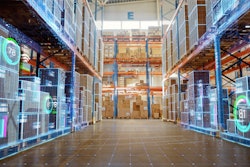
Finding the exact color of shoes in your size online, receiving an order of a dress you bought just in time for your big event, or even successfully returning a pair of jeans purchased online because it didn’t fit correctly are all examples of delightful customer outcomes. But there is so much that happens behind the scenes – and the driving force behind it all is an agile and effective supply chain.
Navigating Choppy Waters with Digital Lighthouses
Since the pandemic, the conversation around supply chains has truly come to the forefront and become a topic of conversation everywhere – be it at the dinner table or the boardroom. Today, there is a shift happening in the supply chain landscape which has drastically changed from 10 years, or even 5 years ago – it has now become more data and systems-driven.
Traditional supply chains are simply not equipped anymore to cater to market complexities and the evolving needs of digital-native consumers. We now need a supply chain of the future – one which is connected, agile, and intelligent providing a bird’s eye view of organizational activities, right from purchasing supplies to customer delivery.
Supply chain control towers (SCCT) replace slow, sequential insights delivery with a control tower approach. Much like a lighthouse where one gets a 360° view and gauges what is approaching the shoreline, SCCTs help navigate choppy waters, achieve better visibility, enable faster course corrections and provide the power to make informed decisions.
CPGs Get More with Supply Chain Control Towers
SCCTs are centralized viewpoints and digital frameworks, defined by connected, personalized dashboards of software and data enabling organizations to leap-frog into transforming their supply chains. Supply chain visibility provides immense value to organizations and is critical to managing disruptions.
A control tower is a dynamic end-to-end capability that enables strategic priorities, solves specific business issues, and delivers measurable benefits by implementing three interwoven components:
- A way of working in the organization and beyond; insight driven, and exception based
- An organization that understands business issues and has the analytical capability to generate actionable insights and improve the process
- A data insight platform that monitors transactional-level data from internal and external sources, automatically separating issues and prompting action by the user
Working in orchestration with your existing technologies and systems, control tower capabilities can help proactively manage supply chains at the right time. This allows leaders to focus on the areas that are causing most of the issues, while the rest of the supply chain can continue functioning, business-as-usual—driving maximum value without a large-scale implementation.
Some of the supply chain analytics common use cases are procurement, manufacturing, inventory management, warehousing, transportation, etc. A use case prioritization framework helps in driving implementation focus. Functional use cases can be segmented into three broad categories, such as operational, functional and strategic analytics. And, because supply chain processes touch several stakeholders within an organization it is important to create the right personas, which needs the right dashboard. Furthermore, mapping of business metric to the right persona is imperative in the construction of the right dashboard. For example, operational analytics is relevant to a manufacturing head, supply chain head and supply chain analyst at an organizational level and might be least important to a finance head.
Next-gen supply chain control towers are increasingly becoming prevalent in the supply chain ecosystem. Supply chain control towers provide end-to-end supply chain visibility, and act as a central hub to gather supply chain data to give decision-makers the ability to analyze, prioritize and resolve issues effectively and identify risks and responses at speed. It brings together people, processes, technology infrastructure, and data to provide actionable insights. For example, when a consumer is browsing through an e-commerce website and a product is out of stock – both the consumer and the company stand to lose something. It is well-known that stockouts cause walkouts. With the help of a control tower, stock-outs can be anticipated, and the root-cause corrected in time. This is just one of the many benefits of control towers.
Thinking Bigger with Next-Gen Control Towers for CPG
Research suggests that the global control tower market is expected to reach $14.6 billion by 2028. In recent years, SCCTs have become strategic investments in supply chain programs for several CPG companies.
Kraftz recently announced that it will be investing heavily in supply chain control tower as a critical part of its digital transformation strategy. It is intended to provide real-time visibility into day-to-to-today plant operations and automation of its supply chain distribution and improve both consumer and channel demand resulting in a collaborated and connected supply chain. Similarly, Amazon, one of the leading e-commerce companies, have implemented an advanced SCCT that allows them to monitor and manage the entire supply chain process, right from production to delivery enabling them to identify and respond to potential issues and make informed decisions to optimize performance and mitigate risks. Another example is Walmart, which has implemented a global supply chain control tower to manage its vast network of suppliers, stores, and distribution centers. The control tower uses advanced analytics and automation to provide real-time visibility into inventory levels, shipping schedules, and other key metrics, allowing Walmart to quickly identify and respond to potential issues.
Today, SCCTs have already begun to show how much they positively contribute to strategic business outcomes and financial value. An absolute must-have is being able to find an implementation partner that understands your needs and successfully integrate SCCT into the organizations’ digital transformation journey in an orchestrated and organized manner. In order to derive greater enterprise value, it is important to identify objectives, key performance indicators, phase-wise roll out plan, and create a roadmap, without which the ultimate benefits cannot be realized.
Building an integrated insights hub for real-time monitoring, action and process visibility on supply chain processes involves scenario planning, predictive and prescriptive analytics, persona-planning and real-time event alerts and visualization, among others. While it is true that it is a tough environment for CPG companies, it doesn’t mean that these companies cannot navigate the landscape and chart a path forward. With SCCTs they can create a whole new next-generation CPG marketplace. Some of the benefits of SCCTs include the following;
- Address present and future stocks as well as targets
- Plan labor scenarios for better productivity
- Cross-functional coordination and management capabilities
- Mitigate risks and build trust with all stakeholders
- Product and customer segmentation
- Insight-driven last-mile to improve customer-centricity
- Identifying visibility and emerging risks upstream and downstream
The Lighthouse of the Future
From taking precautions, providing process visibility to mitigating risks, control towers can do it all. So, it has become extremely important for enterprises to dig deep into their data and understand supply chain performance, the factors that affect it and take its functioning up a notch to deliver even more delightful consumer experiences. There is so much uncertainty and ambiguity in the world of supply chain that it has never been more critical to design and operate systems which will see the situation, anticipate and respond with effectiveness. With an optimal mix of technology, automation and intelligent systems enterprises can make insight-driven business decisions enabling them to thrive in an evolving environment.















![Pros To Know 2026 [color]](https://img.sdcexec.com/mindful/acbm/workspaces/default/uploads/2025/08/prostoknow-2026-color.mduFvhpgMk.png?ar=16%3A9&auto=format%2Ccompress&bg=fff&fill-color=fff&fit=fill&h=135&q=70&w=240)



